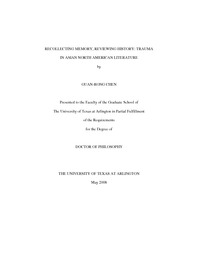
ATTENTION: The works hosted here are being migrated to a new repository that will consolidate resources, improve discoverability, and better show UTA's research impact on the global community. We will update authors as the migration progresses. Please see MavMatrix for more information.
Show simple item record
| dc.contributor.author | Chen, Guan-Rong | en_US |
| dc.date.accessioned | 2008-08-08T02:31:13Z | |
| dc.date.available | 2008-08-08T02:31:13Z | |
| dc.date.issued | 2008-08-08T02:31:13Z | |
| dc.date.submitted | April 2008 | en_US |
| dc.identifier.other | DISS-2053 | en_US |
| dc.identifier.uri | http://hdl.handle.net/10106/961 | |
| dc.description.abstract | My dissertation focuses on representations of traumas in select eight Asian North American novels. I attempt to draw attention to this underrepresented issue of the Asian minority's traumatic experiences. Trauma in my discussion includes double consciousness, national trauma of war, white racism toward the Asian minority, children's perspectives on melancholia and loss, as well as psychosomatic trauma and violence on the female body.
In Chapter One, I argue that in Jade Snow Wong's Fifth Chinese Daughter and
Fae Myenne Ng’s Bone double consciousness is represented as a racial(ized) trauma that creates an ideological dichotomy between East and West, and constrains the identity of the Asian minority within the two. I propose that a multiple identity of racial minorities with performative possibilities in a nation-state should be taken into account. Chapter Two demonstrates how war causes trauma on the private body and memory of victims in Joy Kogawa's Obasan and Lan Cao's Monkey Bridge. War victims collect traumatic memories inside their bodies and recollect these memories repeatedly as corporeal evidence of political persecutions. Chapter Three discusses children's perspectives on melancholia and loss, and their racial/ethnic identification in Lois-Ann Yamanaka's Blu's Hanging and Wayson Choy's The Jade Peony. Both novels provide comical yet critical accounts about children's experience of losing loved ones, their discovery of sexuality, and their acceptance of racial reality during their maturation into adulthood. Chapter Four explores female trauma and transnational connections in Ruth L. Ozeki's My Year of Meats and Lydia Kwa's This Place Called Absence. In these novels, the trauma of the women characters suggests that the female body should be reconfigured beyond the biological function of reproductivity by the heteronormative standard. With the shared experience of violence, the women characters cross the temporal and spatial boundaries, and reflect global concerns about the autonomy of the female body. | en_US |
| dc.description.sponsorship | Morris, Timothy R. | en_US |
| dc.language.iso | EN | en_US |
| dc.publisher | English | en_US |
| dc.title | Recollecting Memory, Reviewing History: Trauma In Asian North American Literature | en_US |
| dc.type | Ph.D. | en_US |
| dc.contributor.committeeChair | Morris, Timothy R. | en_US |
| dc.degree.department | English | en_US |
| dc.degree.discipline | English | en_US |
| dc.degree.grantor | University of Texas at Arlington | en_US |
| dc.degree.level | doctoral | en_US |
| dc.degree.name | Ph.D. | en_US |
| dc.identifier.externalLink | https://www.uta.edu/ra/real/editprofile.php?onlyview=1&pid=1205 | |
| dc.identifier.externalLinkDescription | Link to Research Profiles | |
Files in this item
- Name:
- umi-uta-2053.pdf
- Size:
- 1004.Kb
- Format:
- PDF
This item appears in the following Collection(s)
Show simple item record


